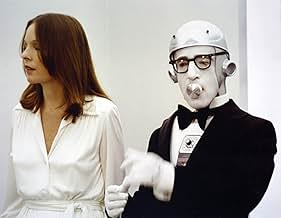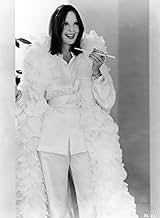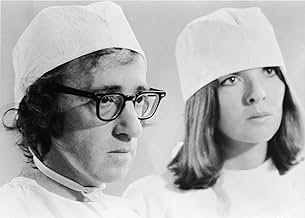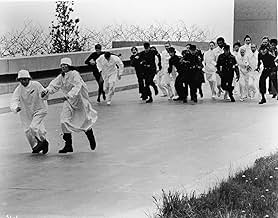VALUTAZIONE IMDb
7,1/10
45.898
LA TUA VALUTAZIONE
Il proprietario di un negozio da nerd viene riportato in vita dalla criostasi in un mondo futuro per combattere un governo oppressivo.Il proprietario di un negozio da nerd viene riportato in vita dalla criostasi in un mondo futuro per combattere un governo oppressivo.Il proprietario di un negozio da nerd viene riportato in vita dalla criostasi in un mondo futuro per combattere un governo oppressivo.
- Premi
- 2 vittorie e 2 candidature totali
Mews Small
- Dr. Nero
- (as Marya Small)
Stanley Ralph Ross
- Sears Swiggles
- (as Stanley Ross)
John Cannon
- Various Voice-Overs
- (voce)
- (non citato nei titoli originali)
Myron Cohen
- Robot Tailor
- (non citato nei titoli originali)
Recensioni in evidenza
Sleeper is a comedy with one of the wittiest premises I've ever seen. It is a comedy about life in the 22nd century through a neurotic Jewish Brooklynite's cynical eyes. No matter how different things are in the future, his perspective doesn't change, his wry sense of humor stays the same, happily misplaced ragtime music plays over the movie, and old-fashioned sight gags are employed complete with the occasional stepped-up film speed.
Allen has always done well playing virtually the same character in all of his movies, but his talent as an on screen comedian is milestoned in this performance. He has the brilliance to mock even the most elusive and unnoticed physical conventions of screen acting, for instance his whispering to Diane Keaton while they pose as doctors in the presence of several people close by. It's a nitpicky sense of humor that contributes greatly to the intelligence behind all of his manic goofiness.
Diane Keaton is his match, however, whereas most of his leading ladies usually aren't. In fact, I hold Diane Keaton's performance in Sleeper as her crowning achievement so far that I've seen of her, even beyond her work in the Godfather films. She delivers great laughs. Her highlight is in what is possibly the funniest scene in the entire film, which eventually involves her doing an impression of Marlon Brando. Who would think that Diane Keaton would deliver the most convincing and dead-on Brando impression one has ever seen. While we're on the subject of that particular part of that hysterical scene that I will preserve for you to see for yourself, I must say that most people, even some of the most talented comedians and office/class clowns can hardly come close to mimicking Brando's voice, expressions and mannerisms. Diane Keaton somehow nails it. In Sleeper, she gives one of the funniest performances I've ever seen from an actress. She and Allen are truly one of the funniest comic pairs I've ever seen in a movie.
What makes Sleeper so funny is not just the physical comedy but the out-of-the-box, completely unorthodox creativity behind all of the physical comedy. There is a scene where someone slips on a banana peel. But the banana peel is the size of a canoe, as is the banana and all of the electronically preserved fruits and vegetables in this particular place, and Allen is being chased by a futuristic cop and both of them are slipping repeatedly on the peel. The film has robot butlers and maids of the future, and gradually throughout the film some are introduced as robots programmed to act and speak like effeminate gay men and Brooklyn Jewish stereotypes. There is also a great amount of intellectualism and cultural knowledge in even the zaniest of humorous moments in Sleeper, and that is what makes it one of Woody Allen's funniest films and a work of true comic genius.
Allen has always done well playing virtually the same character in all of his movies, but his talent as an on screen comedian is milestoned in this performance. He has the brilliance to mock even the most elusive and unnoticed physical conventions of screen acting, for instance his whispering to Diane Keaton while they pose as doctors in the presence of several people close by. It's a nitpicky sense of humor that contributes greatly to the intelligence behind all of his manic goofiness.
Diane Keaton is his match, however, whereas most of his leading ladies usually aren't. In fact, I hold Diane Keaton's performance in Sleeper as her crowning achievement so far that I've seen of her, even beyond her work in the Godfather films. She delivers great laughs. Her highlight is in what is possibly the funniest scene in the entire film, which eventually involves her doing an impression of Marlon Brando. Who would think that Diane Keaton would deliver the most convincing and dead-on Brando impression one has ever seen. While we're on the subject of that particular part of that hysterical scene that I will preserve for you to see for yourself, I must say that most people, even some of the most talented comedians and office/class clowns can hardly come close to mimicking Brando's voice, expressions and mannerisms. Diane Keaton somehow nails it. In Sleeper, she gives one of the funniest performances I've ever seen from an actress. She and Allen are truly one of the funniest comic pairs I've ever seen in a movie.
What makes Sleeper so funny is not just the physical comedy but the out-of-the-box, completely unorthodox creativity behind all of the physical comedy. There is a scene where someone slips on a banana peel. But the banana peel is the size of a canoe, as is the banana and all of the electronically preserved fruits and vegetables in this particular place, and Allen is being chased by a futuristic cop and both of them are slipping repeatedly on the peel. The film has robot butlers and maids of the future, and gradually throughout the film some are introduced as robots programmed to act and speak like effeminate gay men and Brooklyn Jewish stereotypes. There is also a great amount of intellectualism and cultural knowledge in even the zaniest of humorous moments in Sleeper, and that is what makes it one of Woody Allen's funniest films and a work of true comic genius.
Before he became a "serious" filmmaker and gained the respect and admiration of film critics, Woody Allen was already entertaining millions of fans with such unashamedly silly comedies as 1973's 'Sleeper.' The science-fiction story concerns an unfortunate Miles Monroe (Allen), the 1970s owner of the Happy Carrot health-food store, who goes into St. Vincent's Hospital for a routine peptic ulcer operation and wakes up 200 years later in a terrifying police state. He is revived by a subversive underground rebel organisation to help uncover the secrets of the dreaded "Aries Project," and to overthrow the tyrannical government and its dictator. Along the way, Miles enlists the help of the neurotic and exuberant Luna Schlosser (Diane Keaton, who collaborated with Allen on multiple occasions, most notably in 'Annie Hall (1977)' and 'Manhattan (1979)').
A chaotic blend of razor-sharp satire and slapstick humour, 'Sleeper' contains enough of Allen's and co-writer Marshall Brickmann's trademark wit to remind us of what makes their later collaborations so brilliant. Of course, as Allen had yet to reach his creative peak, some of the jokes in the film work (the infamous Orgasmatron; the Volkswagen Beetle that starts up immediately after 200 years of neglect), whilst others aren't pulled off quite so well (the giant chicken; the mock Miss America pageant). In one memorable sequence, year 2173 historians show Miles a collection of historical items and photographs, and he idly gives off ridiculous explanations which they accept as fact. For example, yes, Howard Cosell's sporting reports were used as punishment for criminals who had committed a crime against the state!
The promotional posters for the film proclaimed: "Woody Allen Takes A Nostalgic Look At The Future." This, more than likely, refers to the style of comedy, which, aside from Allen's witty observations, very much evokes memories of the silent slapstick comedies of Lloyd, Keaton and Chaplin. Much like the latter did with most of his films, Allen wrote, directed, starred in and composed the score for 'Sleeper.' The score itself, which is very upbeat, New Orleans-style traditional jazz, was performed by the Preservation Hall Jazz Band with Allen sitting in on clarinet. 'Sleeper' may have been inspired by H.G. Wells' classic novel, 'The Sleeper Awakes,' which recounts the tale of a man who awakes from a 203-year sleep to find himself in a horrifyingly-transformed futuristic London.
Aside from including a wealth of instantly-quotable one-liners ("I'm not really the heroic type. I was beat up by Quakers"), Allen also has a lot of fun in his disorganised futuristic dystopia. After pouring too much "Instant Pudding" into a bowl, the overdone dessert practically comes to life and has to be beaten into submission with a broom; it is also revealed that, contrary to popular agreement in 1973, such substances as deep fat, tobacco and hot fudge are not only not unhealthy, but probably the best thing for your body! When Miles happens upon a garden of human-size fruit and vegetables, we just know that the giant banana peel is going to come into play somewhere, and, sure enough, Miles inevitably takes a tumble.
A chaotic blend of razor-sharp satire and slapstick humour, 'Sleeper' contains enough of Allen's and co-writer Marshall Brickmann's trademark wit to remind us of what makes their later collaborations so brilliant. Of course, as Allen had yet to reach his creative peak, some of the jokes in the film work (the infamous Orgasmatron; the Volkswagen Beetle that starts up immediately after 200 years of neglect), whilst others aren't pulled off quite so well (the giant chicken; the mock Miss America pageant). In one memorable sequence, year 2173 historians show Miles a collection of historical items and photographs, and he idly gives off ridiculous explanations which they accept as fact. For example, yes, Howard Cosell's sporting reports were used as punishment for criminals who had committed a crime against the state!
The promotional posters for the film proclaimed: "Woody Allen Takes A Nostalgic Look At The Future." This, more than likely, refers to the style of comedy, which, aside from Allen's witty observations, very much evokes memories of the silent slapstick comedies of Lloyd, Keaton and Chaplin. Much like the latter did with most of his films, Allen wrote, directed, starred in and composed the score for 'Sleeper.' The score itself, which is very upbeat, New Orleans-style traditional jazz, was performed by the Preservation Hall Jazz Band with Allen sitting in on clarinet. 'Sleeper' may have been inspired by H.G. Wells' classic novel, 'The Sleeper Awakes,' which recounts the tale of a man who awakes from a 203-year sleep to find himself in a horrifyingly-transformed futuristic London.
Aside from including a wealth of instantly-quotable one-liners ("I'm not really the heroic type. I was beat up by Quakers"), Allen also has a lot of fun in his disorganised futuristic dystopia. After pouring too much "Instant Pudding" into a bowl, the overdone dessert practically comes to life and has to be beaten into submission with a broom; it is also revealed that, contrary to popular agreement in 1973, such substances as deep fat, tobacco and hot fudge are not only not unhealthy, but probably the best thing for your body! When Miles happens upon a garden of human-size fruit and vegetables, we just know that the giant banana peel is going to come into play somewhere, and, sure enough, Miles inevitably takes a tumble.
We are blessed that Woody was around, making movies as interesting as this when he was.
Already with this one, he began his vast exploration of movie techniques and devices that would last 25 years or so.
The idea is simple in this one: he wanted to use film slapstick from a bygone era. How better to situate that than to move the whole picture into a future era?
We have some truly classic stuff here. The banana joke, The mirror joke. The robot pantomime. The acting out of the Jewish dinner (done in later movies too). The inflated man joke. You can find all these in any number of Keaton. Marx, Laurel & Hardy movies.
The unifying string of time travel, a romance, the leader and his nose is too weak to make this a solidly recommended outing. And it wouldn't be for a couple years until Woody cared about the cinematography at all.
I had forgotten how pretty Diane Keaton was. Very.
Ted's Evaluation -- 2 of 3: Has some interesting elements.
Already with this one, he began his vast exploration of movie techniques and devices that would last 25 years or so.
The idea is simple in this one: he wanted to use film slapstick from a bygone era. How better to situate that than to move the whole picture into a future era?
We have some truly classic stuff here. The banana joke, The mirror joke. The robot pantomime. The acting out of the Jewish dinner (done in later movies too). The inflated man joke. You can find all these in any number of Keaton. Marx, Laurel & Hardy movies.
The unifying string of time travel, a romance, the leader and his nose is too weak to make this a solidly recommended outing. And it wouldn't be for a couple years until Woody cared about the cinematography at all.
I had forgotten how pretty Diane Keaton was. Very.
Ted's Evaluation -- 2 of 3: Has some interesting elements.
Miles Monroe (director Allen), a health food store owner and jazz clarinetist, goes to a hospital for a routine operation, but something goes wrong and he is put to cryogenic sleep for over 200 years. When he is woken up in the 22nd century, the society has changed into a pleasure-addicted dictatorship. Miles is immediately pulled into revolutionary activity and soon has to flee the state police on his way to the mysterious ruler of the society. He also finds himself teaming up with an initially reluctant woman called Luna (Diane Keaton) and together they adventure through the futuristic society.
The comedic style of Sleeper is an entertaining combination of over-the-top farce and Allen's usual verbal jabs at the society of the 20th century. The silly jazz music accompanying the bumbling chase scenes evokes memories from the silent era (some scenes are even sped-up), and the old masters of slapstick have clearly been a major influence to the style. There are also many references to more modern works of science fiction, such as 2001: A Space Odyssey and Nineteen Eight-Four. Besides the funny farcical scenes, Allen gets to perform his classic neurotic worrying routine that works fine and will amuse fans of his on-screen persona.
A very notable aspect of the film is its visual style: the sets and props all look excellent. The futuristic houses, round vehicles, stiff servant robots, gigantic fruits and even an unruly pudding look hilarious and the many details of the society provide chances to comment on how things are advancing in our times. Be it an orgasm-machine or nonsensical poetry, they seem to suggest we are moving towards times where ignorance revels and empty pleasure-hunting is celebrated as the only correct form of bliss; it can be said that the underlying themes of Sleeper are not unlike those of Aldous Huxley's classic novel Brave New World.
Social commentary aside, Sleeper is also a very funny comedy that appeals not only to friends of Allen's neurotic shtick but also to slapstick fans and admirers of creative production design. Diane Keaton also deserves praise for her performance that features all the necessary comical energy and makes a good pairing for the protagonist Miles. In brief, I laughed out loud several times and would rank the film highly among the handful of Allen films I've seen so far. As far as sci-fi comedies go, Sleeper is a definite winner.
The comedic style of Sleeper is an entertaining combination of over-the-top farce and Allen's usual verbal jabs at the society of the 20th century. The silly jazz music accompanying the bumbling chase scenes evokes memories from the silent era (some scenes are even sped-up), and the old masters of slapstick have clearly been a major influence to the style. There are also many references to more modern works of science fiction, such as 2001: A Space Odyssey and Nineteen Eight-Four. Besides the funny farcical scenes, Allen gets to perform his classic neurotic worrying routine that works fine and will amuse fans of his on-screen persona.
A very notable aspect of the film is its visual style: the sets and props all look excellent. The futuristic houses, round vehicles, stiff servant robots, gigantic fruits and even an unruly pudding look hilarious and the many details of the society provide chances to comment on how things are advancing in our times. Be it an orgasm-machine or nonsensical poetry, they seem to suggest we are moving towards times where ignorance revels and empty pleasure-hunting is celebrated as the only correct form of bliss; it can be said that the underlying themes of Sleeper are not unlike those of Aldous Huxley's classic novel Brave New World.
Social commentary aside, Sleeper is also a very funny comedy that appeals not only to friends of Allen's neurotic shtick but also to slapstick fans and admirers of creative production design. Diane Keaton also deserves praise for her performance that features all the necessary comical energy and makes a good pairing for the protagonist Miles. In brief, I laughed out loud several times and would rank the film highly among the handful of Allen films I've seen so far. As far as sci-fi comedies go, Sleeper is a definite winner.
A futuristic comedy from Woody Allen in 1973 has him waking up from an operation 200 years later (in 2173) to find society has gone berserk.
Clever, witty, and very funny. Allen is hysterically funny as the "sleeper" who gets to give history lessons on the 1970s, pose as a robot, and become a revolutionary to be near Diane Keaton.
Filled with sight gags galore and great one-liners. The giant vegetables and chicken are funny. And so is the "1984" political humor that fits the Bush era better than it did the Nixon era. Also very funny is Allen's extended Blanche du Bois speech.
Allen is excellent as is Keaton. John Beck plays a revolutionary. Mary Gregory is the doctor. George Furth is a party guest. Jackie Mason does the voice of the Jewish tailor.
A must see.
Clever, witty, and very funny. Allen is hysterically funny as the "sleeper" who gets to give history lessons on the 1970s, pose as a robot, and become a revolutionary to be near Diane Keaton.
Filled with sight gags galore and great one-liners. The giant vegetables and chicken are funny. And so is the "1984" political humor that fits the Bush era better than it did the Nixon era. Also very funny is Allen's extended Blanche du Bois speech.
Allen is excellent as is Keaton. John Beck plays a revolutionary. Mary Gregory is the doctor. George Furth is a party guest. Jackie Mason does the voice of the Jewish tailor.
A must see.
Lo sapevi?
- QuizWoody Allen originally intended the film to be three hours long and in two parts. The first part would have him in the present day, coping with life until his illness. And the second half would be the futuristic part. But United Artists rejected this concept.
- BlooperLuna's shoes change from high heels to flats when she crosses the lake on Miles' back (in the "raft" costume).
- Citazioni
Luna Schlosser: It's hard to believe that you haven't had sex for 200 years.
Miles Monroe: 204, if you count my marriage.
- ConnessioniEdited into Intimate Portrait: Diane Keaton (2001)
- Colonne sonoreTill We Meet Again
(1918) (uncredited)
Music by Richard A. Whiting
Lyrics by Ray Egan
Performed by Woody Allen
I più visti
Accedi per valutare e creare un elenco di titoli salvati per ottenere consigli personalizzati
- How long is Sleeper?Powered by Alexa
Dettagli
- Data di uscita
- Paese di origine
- Lingue
- Celebre anche come
- El dormilón
- Luoghi delle riprese
- Sculptured House - 24501 Ski Hill Drive, Golden, Colorado, Stati Uniti(mushroom shaped building, top of mountain on south side of I-70)
- Aziende produttrici
- Vedi altri crediti dell’azienda su IMDbPro
Botteghino
- Budget
- 2.000.000 USD (previsto)
- Lordo Stati Uniti e Canada
- 18.344.729 USD
- Lordo in tutto il mondo
- 18.344.868 USD
Contribuisci a questa pagina
Suggerisci una modifica o aggiungi i contenuti mancanti






















